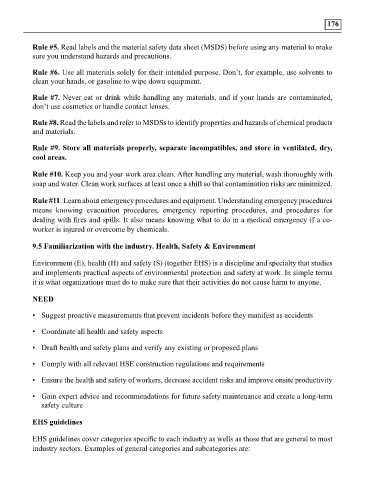Page 176 - Warehouse 1 to 9
P. 176
176 177
Rule #5. Read labels and the material safety data sheet (MSDS) before using any material to make 1.Environmental
sure you understand hazards and precautions.
1.1 Air emissions and ambient air quality
Rule #6. Use all materials solely for their intended purpose. Don’t, for example, use solvents to
clean your hands, or gasoline to wipe down equipment. 1.2 Energy conservation
Rule #7. Never eat or drink while handling any materials, and if your hands are contaminated, 1.3 Wastewater and ambient water quality
don’t use cosmetics or handle contact lenses.
1.4 Water conservation
Rule #8. Read the labels and refer to MSDSs to identify properties and hazards of chemical products
and materials. 1.5 Hazardous materials management
Rule #9. Store all materials properly, separate incompatibles, and store in ventilated, dry, 1.6 Waste management
cool areas.
1.7 Noise
Rule #10. Keep you and your work area clean. After handling any material, wash thoroughly with
soap and water. Clean work surfaces at least once a shift so that contamination risks are minimized. 1.8 Contaminated land
Rule #11. Learn about emergency procedures and equipment. Understanding emergency procedures 2. Occupational health and safety
means knowing evacuation procedures, emergency reporting procedures, and procedures for
dealing with fires and spills. It also means knowing what to do in a medical emergency if a co- 2.1 General facility design and operation
worker is injured or overcome by chemicals. 2.2 Communication and training
9.5 Familiarization with the industry. Health, Safety & Environment 2.3 Physical hazards
Environment (E), health (H) and safety (S) (together EHS) is a discipline and specialty that studies 2.4 Chemical hazards
and implements practical aspects of environmental protection and safety at work. In simple terms
it is what organizations must do to make sure that their activities do not cause harm to anyone. 2.5 Biological hazards
NEED 2.6 Radiological hazards
• Suggest proactive measurements that prevent incidents before they manifest as accidents 2.7 Personal protective equipment (PPE)
• Coordinate all health and safety aspects 2.8 Special hazard environments
• Draft health and safety plans and verify any existing or proposed plans 2.9 Monitoring
• Comply with all relevant HSE construction regulations and requirements 3. Occupational health and safety
• Ensure the health and safety of workers, decrease accident risks and improve onsite productivity 3.1 Water quality and availability
• Gain expert advice and recommendations for future safety maintenance and create a long-term 3.2 Structural safety of project infrastructure
safety culture
3.3 Life and fire safety (L&FS)
EHS guidelines
3.4 Traffic safety
EHS guidelines cover categories specific to each industry as wells as those that are general to most
industry sectors. Examples of general categories and subcategories are:

